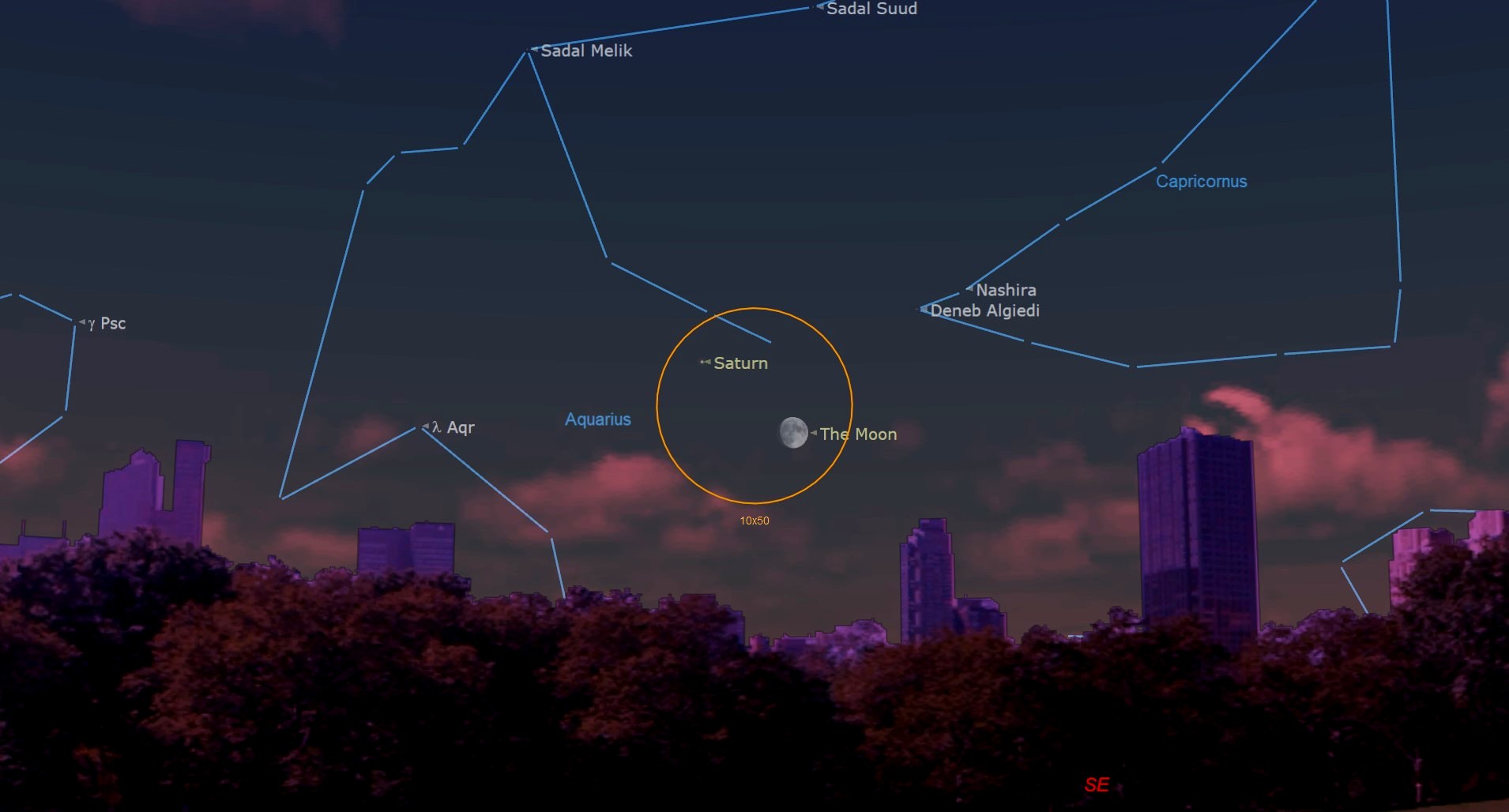See the moon and Saturn shine side-by-side in the night sky tonight
Tuesday evening (Sept. 26) will bring us a fine opportunity to make a positive identification of what many consider to be the most beautiful of all telescopic objects, the ringed planet Saturn.
And, in fact, another celestial body will help point the way to it: the moon, which will be in its waxing gibbous phase that same night.
As I have noted over the years here at Space.com, to the unaided eye, Saturn does not possess any outstanding features that call attention to it. It lacks the dazzling, eye-popping brilliance of Venus or Jupiter and it does not have the fiery orange-yellow of Mars.
In fact, to the human eye, Saturn appears as nothing more than a very bright "star" that shines with a yellowish-white glow. Most people presently looking around the early autumn sky might even take note of this sight as they look one-quarter of the way up from the southeast horizon to a point directly overhead at around 8 p.m. local daylight time, not knowing they are looking at the solar system's ringed wonder.
Related: Night sky, September 2023: What you can see tonight [maps]
But on Tuesday, the moon will be situated to the lower right of Saturn.
If it is clear, that evening will be a great night to invite your friends and neighbors over to peer through your eyepiece at both Saturn and our nearest neighbor in space; two wonderful sky objects.
Breaking space news, the latest updates on rocket launches, skywatching events and more!
First, the moon

Looking for a telescope to see the moon? We recommend the Celestron Astro Fi 102 as the top pick in our best beginner's telescope guide.
First, you'll want to check out the moon. A full moon looks "flat" and one-dimensional, though its brilliance may dazzle the eye. But Tuesday’s moon won't be quite full, but rather 92 percent sunlit. It will also shine about half as bright as it would if full. Moreover, check out the region along the terminator — that part of the moon that separates the light zone from the dark zone. Take note especially of a rather brightly lit crater situated adjacent to the terminator on the upper part of the moon. That's Aristarchus, an impact crater considered to be the brightest of all large formations on the lunar surface.
Then, check out the lower part of the lunar disk, which falls immediately along the terminator and you will see many craters casting shadows that make them dramatically stand out.
Next comes Saturn
After you are done showing off the moon to your friends, it will then be time to turn your telescope toward Saturn.
Your clenched fist at arm's length is equal to roughly 10 degrees — Saturn will be situated less than "half a fist" (4 degrees) to the upper left of the moon.
Any telescope with an eyepiece magnifying at least 30-power will reveal the planet's famous ring system, which is currently tilted 10-degrees toward our planet. The best views of Saturn will depend on the size of your telescope. My recommendation is not to use your telescope's highest power (which can magnify turbulence in the atmosphere and make the image appear to "boil" or "quiver"), but a more moderate magnification. With a 3-inch telescope, try 75-power; with a 6-inch, 150-power; and with a 10-inch, 250-power.
Even for experienced, seasoned observers, the sight of Saturn's rings in a moderate or large telescope still brings surprise and astonishment!
A final "gee-whiz" fact you can reveal to your friends is that what you are seeing in Tuesday’s sky is an illusion of perspective. The moon and Saturn are nowhere near each other in space. The moon will be 222,900 miles (358,500 km) from Earth as you view it, while Saturn will fall more than 3,700 times farther away at 827 million miles (1.331 billion km) from your vantage point.
If you're looking for a telescope or binoculars to observe the moon, our guides for the best binoculars deals and the best telescope deals now can help. Our best cameras for astrophotography and best lenses for astrophotography can also help you prepare to capture the next skywatching sight on your own.
Editor's Note: If you snap your own photos of the moon and Saturn and would like to share them with Space.com’s readers, send your photo(s), comments, and your name and location to spacephotos@space.com.

Joe Rao is Space.com's skywatching columnist, as well as a veteran meteorologist and eclipse chaser who also serves as an instructor and guest lecturer at New York's Hayden Planetarium. He writes about astronomy for Natural History magazine, Sky & Telescope and other publications. Joe is an 8-time Emmy-nominated meteorologist who served the Putnam Valley region of New York for over 21 years. You can find him on Twitter and YouTube tracking lunar and solar eclipses, meteor showers and more. To find out Joe's latest project, visit him on Twitter.

